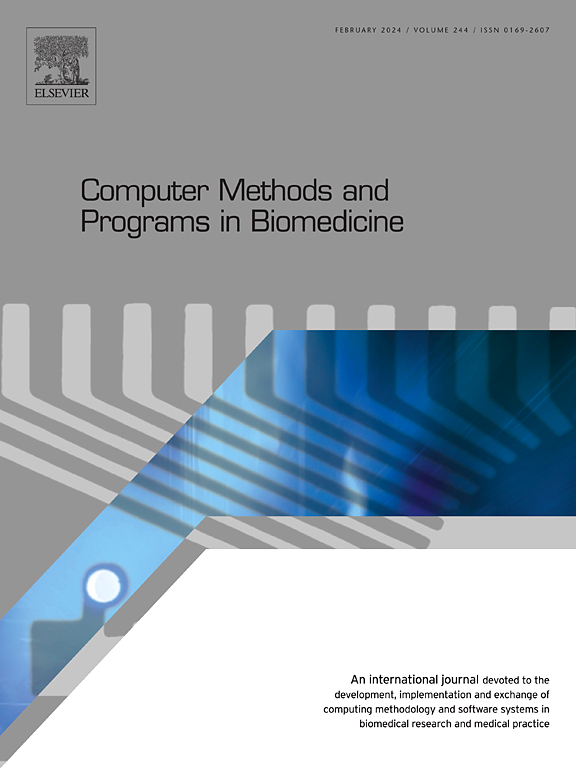RPF-Net:基于CT和全片图像的非转移性ccRCC术后UISS风险分层的多模式模型
IF 4.9
2区 医学
Q1 COMPUTER SCIENCE, INTERDISCIPLINARY APPLICATIONS
引用次数: 0
摘要
背景与目的非转移性透明细胞肾细胞癌(nccRCC)患者术后面临肿瘤复发和转移的风险。然而,nccRCC的预后评估仍然耗时且主观。在目前的诊断领域,计算机断层扫描(CT)图像提供宏观解剖信息,而全幻灯片图像(wsi)提供CT成像无法获得的微观细节。为了解决这一差距,该研究提出了一种多模式方法,利用CT和WSI数据来开发nccRCC术后风险分层的自动化模型。方法本研究提出了一个多模式模型,称为放射病理学融合网络(RPF-Net),该模型采用自我注意、图形注意和动态注意融合机制,将CT图像和wsi整合在一起,根据加州大学洛杉矶分校的综合分期系统(UISS)标准将nccRCC患者分为低风险和中高风险组。该模型分为三个步骤。首先,利用ResNet-50和3D ResNet-50作为特征提取器,分别从wsi和CT图像中提取具有代表性的特征图。其次,设计了双分支模块来提取wsi的全局和局部特征。最后,开发了多层动态注意力融合(MDAF)模块,促进跨模态特征交互,预测风险分层结果。结果内部验证集RPF-Net的曲线下面积(AUC)、准确度、精密度和F1评分分别为0.949±0.013、0.894±0.019、0.895±0.020和0.894±0.019。此外,RPF-Net在外部验证集上的AUC为0.901,在公共数据集上的AUC为0.924。结论RPF-Net对多模态数据的诊断过程进行了建模,具有较强的泛化能力和较好的性能。该模型可能是促进nccRCC术后患者临床风险分层和管理的潜在工具。本文章由计算机程序翻译,如有差异,请以英文原文为准。
RPF-Net: A multimodal model for the postoperative UISS risk stratification of non-metastatic ccRCC based on CT and whole-slide images
Background and objectives
Postoperative non-metastatic clear cell renal cell carcinoma (nccRCC) patients face the risk of tumor recurrence and metastasis. However, prognosis assessment for nccRCC remains time-consuming and subjective. In the current diagnostic landscape, computed tomography (CT) images provide macro-scale anatomical information, and whole-slide images (WSIs) offer micro-scale details that are inaccessible to CT imaging. To address this gap, the study proposes a multimodal approach that leverages both CT and WSI data to develop an automated model for postoperative risk stratification in nccRCC.
Methods
This study proposes a multimodal model named the Radiology-Pathology Fusion Network (RPF-Net), which employs self-attention, graph-attention, and dynamic attention fusion mechanisms to integrate CT images and WSIs for classifying nccRCC patients into low-risk and intermediate-high-risk groups per the University of California, Los Angeles, Integrated Staging System (UISS) criteria. The proposed model is divided into three steps. First, the ResNet-50 and 3D ResNet-50 are used as feature extractors to respectively extract representative feature maps from WSIs and CT images. Second, a dual-branch module is designed to extract global and local features of the WSIs. Finally, a multilayer dynamic attention fusion (MDAF) module is developed to facilitate cross-modal feature interaction and predict the risk stratification results.
Results
The area under the curve (AUC), accuracy, precision, and F1 Score of the RPF-Net on the internal validation set are 0.949±0.013, 0.894±0.019, 0.895±0.020, and 0.894±0.019, respectively. Furthermore, the RPF-Net shows robust generalization, achieving an AUC of 0.901 on the external validation set and 0.924 on the public dataset.
Conclusions
The RPF-Net models the diagnostic process of multimodal data and shows strong generalization and excellent performance. This model may be a potential tool to facilitate clinical risk stratification and management for postoperative nccRCC patients.
求助全文
通过发布文献求助,成功后即可免费获取论文全文。
去求助
来源期刊

Computer methods and programs in biomedicine
工程技术-工程:生物医学
CiteScore
12.30
自引率
6.60%
发文量
601
审稿时长
135 days
期刊介绍:
To encourage the development of formal computing methods, and their application in biomedical research and medical practice, by illustration of fundamental principles in biomedical informatics research; to stimulate basic research into application software design; to report the state of research of biomedical information processing projects; to report new computer methodologies applied in biomedical areas; the eventual distribution of demonstrable software to avoid duplication of effort; to provide a forum for discussion and improvement of existing software; to optimize contact between national organizations and regional user groups by promoting an international exchange of information on formal methods, standards and software in biomedicine.
Computer Methods and Programs in Biomedicine covers computing methodology and software systems derived from computing science for implementation in all aspects of biomedical research and medical practice. It is designed to serve: biochemists; biologists; geneticists; immunologists; neuroscientists; pharmacologists; toxicologists; clinicians; epidemiologists; psychiatrists; psychologists; cardiologists; chemists; (radio)physicists; computer scientists; programmers and systems analysts; biomedical, clinical, electrical and other engineers; teachers of medical informatics and users of educational software.
 求助内容:
求助内容: 应助结果提醒方式:
应助结果提醒方式:


